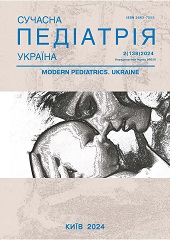Vegetative disorders and adaptive behavioural reactions at autonomic dysfunction syndrome in children after COVID-19 infection
DOI:
https://doi.org/10.15574/SP.2024.138.51Keywords:
children, autonomic homeostasis, COVID-19, somatoform autonomic dysfunction, variability of heart rhythmAbstract
Aim - to study the features of autonomic homeostasis as one of the markers of the body impaired adaptive mechanisms and the development of pathology in children after SARS-CoV-2 infection.
Materials and methods. There are 95 children aged 7-14 years were included. The study group included the 75 children without chronic pathology who had a mild or moderate course of COVID-19 infection and had laboratory confirmation of the disease. The control group included 20 children who had no COVID-19 infection. The state of the autonomic nervous system was assessed by the Cardio-Spectrum rapid heart rate variability analysis system according to the conventional methodology with the calculation of the tension index (Baevsky Index), which reflects the balance of the sympathetic and parasympathetic divisions of the ANS. Statistical processing of the obtained data was performed with application package "Statistica 10.0 for Windows" by the method of variation statistics.
Results. All children from both groups had symptoms of somatoform autonomic dysfunction. It was discovered that 54.7% of children with COVID-19 had vagotonia, 24% had sympathicotonia, and 21.3% had euthonia, what is significantly different from the distribution in the comparison group. After analyzing the wave structure of the variability of heart rhythm in children after COVID-19 it was noted a significant increasing of all components of the spectrum. These results characterize an increasing of the absolute level of activity of regulatory systems. Given into account the multidirectional nature of vegetative shifts in children after COVID-19, a comprehensive method of correction was proposed. This method include in addition to medications a rational diet, treatment of physical and mental stress, psychotherapy, and the elimination of factors supporting the presence of chronic stress.
Conclusions. The COVID-19 infection leads to tension in the adaptive mechanisms of autonomic regulation with a shift towards the depletion of compensatory mechanisms.
The research was carried out in accordance with the principles of the Declaration of Helsinki. Informed consent of the child and child's parents was obtained for the research.
No conflict of interest was declared by the authors.
References
Aragón-Benedí C, Oliver-Forniés P, Galluccio F et al. (2021, Mar 24). Is the heart rate variability monitoring using the analgesia nociception index a predictor of illness severity and mortality in critically ill patients with COVID-19? A pilot study. PLoS One. 16(3): e0249128. https://doi.org/10.1371/journal.pone.0249128; PMid:33760875 PMCid:PMC7990300
Chekman IS, Guschina LN, Gushchin NV, Korenkova SG. (2002). Clinical efficiency of the drug Kratal in the ambulatory treatment of patients with neurocirculatory dystonia. Ukrainian Medical Magazine. 4: 127-130.
Davies P, Evans C, Kanthimathinathan HK et al. (2020). Intensive care admissions of children with paediatric inflammatory multisystem syndrome temporally associated with SARS-CoV-2 (PIMS-TS) in the UK: a multicentre observational study. Lancet Child Adolesc Health. 4(9): 669-677. https://doi.org/10.1016/S2352-4642(20)30215-7; PMid:32653054
Gorbenko NI, Ivanova OV, Borikov AYu. (2016). Oxidative stress as a pathophysiological mechanism in the development of diabetic macroangiopathies and prospects for its correction with the help of flavonoids. Problems of endocrine pathology. 3: 91-99. https://doi.org/10.21856/j-PEP.2016.3.10
Gorchakova NA. (2001). Kratal - a new domestic product with a cardio protective action. Weekly Pharmacy: 293.
Gorodkova YV, Kurochkin MY, Davidova AG, Podlianova OI. (2022). Klinichni proiavy urazennia serdcevo-sudynnoyi systemy u ditei yak naslidok perenesennoy koronovirusnoy hvorobi (COVID-19) (klinichniy vipadok). Zaporizkiy medichniy Zurnal. 3(132): 375-380. https://doi.org/10.14739/2310-1210.2022.3.251076
Govorin AV, Filev AP. (2012). Omega-3 polyunsaturated fatty acids in the treatment of patients with cardiovascular diseases. Rational Pharmacotherapy in Cardiology. 8(1): 95-102. https://doi.org/10.20996/1819-6446-2012-8-1-95-102
Holboev SB, Yusupov SA, Yuldashova NE. (2021). Rezultaty sposteregennia za osobamy, yaki perenesli COVID-19, na pervinniy lanci ohorony zdorovia. Infekciyni hvorobi. 1(103): 18-22. https://doi.org/10.11603/1681-2727.2021.1.11948
IPOG. (2019). Zvit pro NDR Instytutu pediatrii, akusherstva i hinekolohii NAMN Ukrainy. 1: 1-57.
Kaliyaperumal D, Rk K, Alagesan M, Ramalingam S. (2021). Characterization of cardiac autonomic function in COVID-19 using heart rate variability: a hospital based preliminary observational study. J Basic Clin Physiol Pharmacol. 32(3): 247-253. https://doi.org/10.1515/jbcpp-2020-0378; PMid:33705614
Karpov YuA. (2014). œ-3-polyunsaturated fatty acids: application today and prospects for use in clinical practice. Atmosphere. Cardiology new. 2: 43-45.
Li K, Huang T, Zheng J et al. (2014). Effect of marine-derived n-3 polyunsaturated fatty acids on C-reactive protein, interleukin 6 and tumor necrosis factor: a meta-analysis. PLoS One. 9(2): e88103. https://doi.org/10.1371/journal.pone.0088103; PMid:24505395 PMCid:PMC3914936
Maksyutina NP, Moybenko AA, Mohort NA et al. (2012). Bioflavonoids as organ protectors. Quercetin. Corvitin. Kvertin. K.: Scientific thought. 274 p.
Pacheco FJ, Almaguel FG, Evans W et al. (2014). Docosahexanoic acid antagonizes TNF-induced necroptosis by attenuating oxidative stress, ceramide production, lysosomal dysfunction, and autophagic features. Inflamm. Res. 63(10): 859-871. https://doi.org/10.1007/s00011-014-0760-2; PMid:25095742 PMCid:PMC4205108
Ross JA, Kasum CM. (2002). Dietary flavo- noids: bioavailability, metabolic effects, and safety. Annu Rev Nutr. 22:19-34. https://doi.org/10.1146/annurev.nutr.22.111401.144957; PMid:12055336
Su KP, Lai HC, Yang HT et al. (2014). Omega-3 Fatty acids in the prevention of interferon-alpha-induced depression: results from a randomized, controlled trial. Biol. Psychiatry. 76(7): 559-566. https://doi.org/10.1016/j.biopsych.2014.01.008; PMid:24602409
Downloads
Published
Issue
Section
License
Copyright (c) 2024 Modern pediatrics. Ukraine

This work is licensed under a Creative Commons Attribution-NonCommercial 4.0 International License.
The policy of the Journal “MODERN PEDIATRICS. UKRAINE” is compatible with the vast majority of funders' of open access and self-archiving policies. The journal provides immediate open access route being convinced that everyone – not only scientists - can benefit from research results, and publishes articles exclusively under open access distribution, with a Creative Commons Attribution-Noncommercial 4.0 international license (СС BY-NC).
Authors transfer the copyright to the Journal “MODERN PEDIATRICS. UKRAINE” when the manuscript is accepted for publication. Authors declare that this manuscript has not been published nor is under simultaneous consideration for publication elsewhere. After publication, the articles become freely available on-line to the public.
Readers have the right to use, distribute, and reproduce articles in any medium, provided the articles and the journal are properly cited.
The use of published materials for commercial purposes is strongly prohibited.

